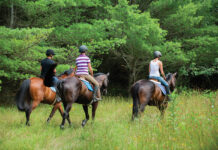Q: I have a gelding that I bought for trail riding. Unfortunately, his previous owner used to gallop him a lot on the trails, so he constantly wants to bolt off. His mouth is dull too, which makes matters worse. Do you have any tips on how I could possibly retrain him to go the speed I want?

Here is one example of how to achieve this goal. Work in a quiet, flat area. Start at the walk, holding a rein in each hand. Increase the contact with your right rein and ask your horse to tip his nose to the right and bend his neck to follow. Press in with your right leg, against his rib cage, until you feel him shift his body slightly to the left. Your horse should create a small circle, in essence bending around your inside (right) leg. Envision a circle the diameter of a long lead rope, not a tight barrel racer turn. Once he completes his circle, relax your contact on the right rein, walk forward several steps, and repeat the process to the left, reversing your leg cue. Next you can add larger circles (the diameter of a longe line), progress to the jog, and work on transitions from one gait to the next. For instance, ask your horse to halt from the trot and back up. If you decide to canter (a slow gallop), stick to a few large circles, then ask him to walk. Remember, if you lack control and authority here, you’re liable to encounter problems on the trails.
When you do venture out on the trails again, find some opportunities to school your horse. There’s no reason why you can’t break up long stretches of flat, even ground with a medley of a slow jog, a trot, transitioning down to a walk, etc. In wide, more open areas, bend your horse in a large, gentle circle. Avoid cantering or galloping until you’re confident that your horse is listening to your requests. If you feel overwhelmed with the concept of re-schooling your horse, then seek some support from a veteran rider in your area who can put some structured rides on your horse.
–Cindy Hale
Liked this article? Here are others you’ll love:
Trail Problem Solver: Bolting
Trail Ride Manners






Good advise, alway start “small” moves and alway set your horse up to win.
I know a few people who have used similar techniques to get their horse to listen to them on the trail, the key is to make sure they know exactly what you’re asking for because you’ve practiced it at home.
I had the same situation. I used the same re-schooling and it does work. Even when he gets a little silly we do a circle. It makes him focus on something else and when they realise their silliness leads to work, it is easier to control. When he is very silly or hot, we do several circles, smaller ones or even disengage. The amount of work depends on him. Grey is right, they have to know the moves BEFORE going out on trail.
this is great info thank you
I was having the same problem with my mare. Yes the circles, bending the horse did help and also a deep breath exhale and relax making sure you are leaning back a bit rather than having your weight forward. Our communication has improved a lot since we practice and I now look forward to our sessions.
Great advice.
Thanks for the tips- I hate having a horse rushes on a trail
Thanks for the great tips.
good tips!
Thank You for the good information.
yes
I would think going with a quiet horse leading would help on the first trail ride after “re-training”, too.
Great tips. Also, the more often you gallop on the trails with your horse the less likely he is to take off because it won’t be a new and exciting/scary experience.
I concur with Julie Goodnight’s observation when responding to this situation…A good moving horse is a blessing and many gaited horses fall in this catagory. If yours does, find another horse to ride with the slow riders and enjoy the great gaits of your horse with riders who ride at a faster pace.
Good advise in this article. Thank You Horse Channels for providing it.
Good advise, I hope I can remember it all, “if” my horse ever bolts or takes off on me.